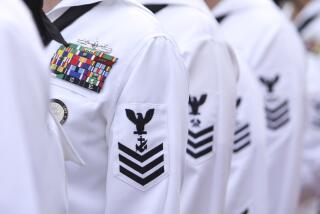U.S. Recruits Get Lessons on Soviet Foes in Red Star Garb
- Share via
SAN DIEGO — The accent is Russian and the uniform is that of the Soviet navy. The attitude is thick with contempt and superiority.
Recruits at the Naval Training Center in San Diego lean forward as a man identified as Petty Officer Alexei Ivanovich Menshikov berates them as weaklings and mindless slaves to their “capitalist, imperialist” masters.
“You do not wear the uniform because of love for the motherland,” he tells the recruits. “You wear the uniform because you cannot find jobs in your bankrupt economy. What is better--a navy of patriotic conscriptees or a navy of mercenaries?”
Soviet sailors willingly serve nine-month deployments and need only 10 days leave every three years, while American sailors are forever lusting for the fleshpots of Subic Bay and other ports, he tells them.
“A Soviet ship is built for combat, not for providing luxurious transportation from one decadent port visit to another,” he says.
The speaker, of course, is not Soviet--federal law prohibits Soviet citizens from visiting military-laden San Diego. Rather, he is Charles Childress, 29, an intelligence specialist first class assigned to the U.S. Navy’s Soviet Seapower Education Program.
Program’s Purpose Described
The program is meant to provide sailors and Marines with insight into the abilities and motivations of their Soviet rivals.
The Menshikov tirade and a similar one presented by an ersatz Soviet naval lieutenant cap a two-hour presentation spiced with Soviet music, a slide show, excerpts from Soviet television shows, and an ABC-TV documentary on the Russian people.
The hall is decked with Soviet propaganda posters, flags and naval warfare crests.
Film clips show the recent U.S.-Soviet summit, the 1962 Cuban missile crisis, and President John F. Kennedy’s dramatic address to the nation warning of war with the Soviets if the missiles were not removed.
President Reagan and Soviet leader Mikhail S. Gorbachev may be dining together these days in the White House and talking about the warming trend in superpower relations--but the U.S. military still must find ways to keep its troops psychologically prepared to fight.
The Soviet sea power program--described as a modern-version of the traditional “know your enemy” lecture--is unceasingly hostile to communism and suspicious of Soviet intentions.
But it also gives a sympathetic portrayal of the Soviet people, their bravery and sacrifices during World War II, and the hardships they endure under a “closed police state.” A distinction is drawn between the Soviet people and their government.
The lecturers are cautious but hopeful when they mention glasnost and perestroika --Gorbachev’s pledge to overhaul the militaristic Soviet economy.
One point is mentioned repeatedly: That the death of 20 million Russians during World War II left the society paranoid about any perceived military threat to the “motherland.”
The Soviet government, the young audience is told, exploits these painful memories and turns them into “a psychic scar that is not allowed to heal.”
A film clip shows an elderly woman on a street in Moscow: “My sister and two brothers died in the fighting. When I remember it, I feel so bad. We hope it will never be repeated.”
Part of a documentary narrated by actor Jack Palance shows Russians weeping at a mammoth war monument in Stalingrad.
The presentation praises Soviet sailors as disciplined, physically fit and well-trained but notes that the Soviet military suffers the same ills as the civilian workforce. Those ills include rampant alcoholism, friction among ethnic groups and a regimentation that saps the spirit and undermines effectiveness.
“The Soviet sailor is our greatest potential adversary,” Lt. Cmdr. Richard Papworth says at the beginning. “But we also want to talk about his weaknesses so we can learn, like these trainers in the Moscow Zoo, to tame the Soviet bear.”
Even-Handed Approach
Papworth, 36, has a bachelor’s degree in international relations from USC and a master’s degree in national security from the Naval Postgraduate School. As director, he sees the program as a straight-forward presentation of the facts, neither overly rosy nor a belligerent exercise in Russian-bashing.
“Our goal is to stress Soviet motivation, to help our people understand why the Soviets do what they do,” Papworth said in an interview. “There seems to be a mistaken perception that, deep down, the Soviets are the same as us. We try to show that there are true differences.”
Not surprisingly, the Soviets are not amused.
The Soviet Army newspaper Red Star branded the program as “a super-dose of anti-Soviet venom, which should paralyze critical thinking and rouse fits of wicked hatred for the Soviet people.” It said the program proves that the United States is preparing to attack.
Developed in 1983 by the Navy and Marine Corps Intelligence Training Center in Dam Neck, Va., the Soviet sea power program is presented 90 to 95 times a year at American bases throughout the world. It also been shown in the Philippines, Canada and the United Kingdom.
Similar Programs Elsewhere
Similar programs have been developed by the Army and Air Force; the Army’s Soviet Orientation Team is particularly active in Europe. The Marine Corps has a course called The Threat for troops studying Soviet tactics at the desert base at Twentynine Palms.
The two-hour version of the Navy’s Soviet Seapower Program is open to all military personnel, and occasionally to military families, the press and other civilians.
Military personnel with security clearances are given a longer version that provides additional details comparing U.S. and Soviet weaponry and tactics.
Slides show Soviet children learning at age 10 how to handle automatic rifles and throw dummy hand grenades. The sailors and Marines are told that Soviet children attend military summer camps and that officers serve a minimum 20-year enlistment.
The program tells of chronic shortages of consumer goods, a rising infant mortality rate, a declining life expectancy among adult males, and bad food and brutal conditions aboard Soviet ships.
Tim McDaniel, an associate professor of sociology at UCSD, said in an interview that, as described to him by a reporter, the program appears generally accurate and consistent with the view of the Soviet Union held by most academics.
In Basic Agreement
He said his own work, including time spent studying in the Soviet Union, leads him to agree with a major tenet of the presentation--that the Russians’ reverence for their homeland does not translate into a similar affection for communism.
“Solzhenitsyn has said that there are more communists in the United States than in Russia,” noted McDaniel, a specialist in Russian culture and author of a new book, “Autocracy, Capitalism and Revolution in Russia.”
The attempted intimidation by the mock Soviets often brings a hostile reaction from members of the audience, many of whom are initially taken in by the impersonations.
“What about Afghanistan?” one sailor shouted after Kapitan-Leytenant Yuri Ivanovich Korov, played by Lt. Tim Duvall, sneered that American foreign policy is dominated by “reckless imperialism” and “gangsterism.”
“Sometimes it can get pretty hot, particularly if there are Marines present,” said Childress, who plays the Soviet petty officer. “We had a wild time recently at the Marine base in Kanehoe, Hawaii. That’s good, because it shows they’re listening and challenging us.”
Some of the sailors and Marines have been known to approach Childress and Duvall even after the hoax has been revealed.
“They talk to us real loud and real slow, like we’re foreigners,” Duvall said.
The audience at the San Diego base was quieter than most. Many of the recruits had been up since 5 a.m. and put in an exhausting day. Still, a number started to bristle noticeably.
“I was starting to get mad when that Russian started insulting us,” said Nick Fuchs, 21, a seaman apprentice. “They say the Soviet sailor is in the best physical shape of any sailor in the world, but those guys seemed scrawny to me.
“I hope it never comes to that, but if they think they’re bad enough, we’re going to be ready.”
More to Read
Sign up for Essential California
The most important California stories and recommendations in your inbox every morning.
You may occasionally receive promotional content from the Los Angeles Times.










